|


256-bit encryption
$500,000 protection

|
GOLDEN HIND
Golden
Hind was a galleon captained by Francis Drake in his
circumnavigation of the world between 1577 and 1580. The extraordinary voyage
included battles in Spanish colonial settlements, the
capture of treasure ships, and a near-mutiny as well as
the usual maritime hazards of storms, scurvy, and
running aground on coral reefs.
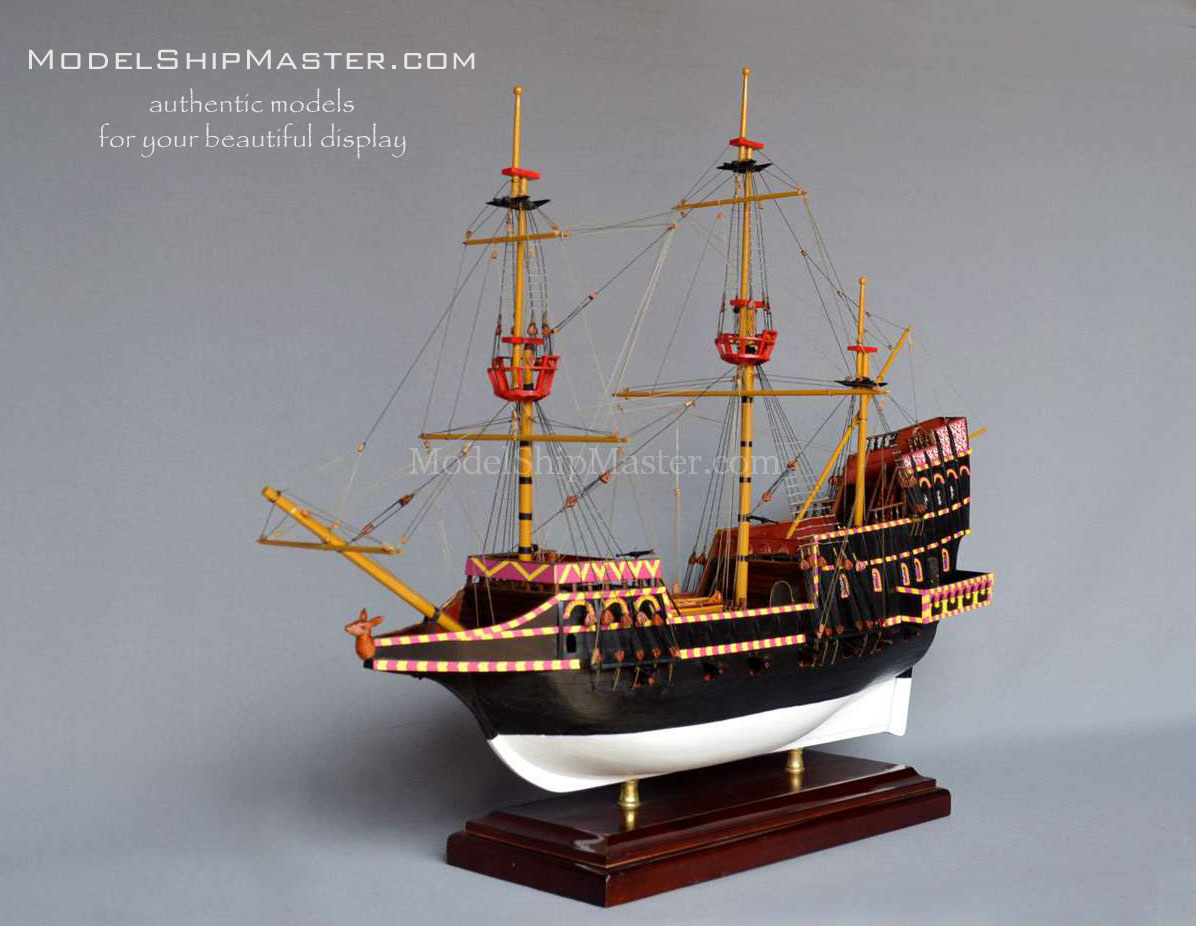
The idea to mount an expedition to explore what lay
south of the equator and see if a great southern
continent did really exist was first touted by Richard
Grenville (1542-1591) in 1574. In 1577, queen Elizabeth
turned to Drake for just such a southern voyage.
Secretly, she invested in the project and instructed
Drake not only to explore new trade possibilities but
also to take whatever treasure he came across from the
Spanish and attack Spanish colonial settlements in South
America. For this task, Drake was given command of a
fleet of five ships and 164 men. His flagship was
the Golden Hind. In November 1577,
before
setting sail, the queen told him:
"We would gladly be revenged on the King of Spain
for divers injuries that we have received."
The expedition got off to the worst possible start when
a storm damaged several of the ships and they were
obliged to return to port only two weeks after setting
off. The fleet set off for a second time on 13 December
and sailed down the coast of northwest Africa and then
across the Atlantic route via the Cape Verde Islands.
They attacked three ships and looted their cargoes. One
one of them was added to Drake’s small fleet.
After two months with no sight of land, the fleet
finally reached the eastern coast of South America,
north of the River Plate, in April 1578. Three ships
were abandoned by August as too unseaworthy to make the
voyage into the Pacific Ocean.
At the
southern tip of South America, the three remaining ships
pressed on through the Straits of Magellan in August.
The Straits were difficult to find and dangerous, but
after getting through, heavy storms in September meant
that one ship was wrecked and another sailed back to
England. The Golden Hind was obliged to continue the
expedition alone.
The Golden Hind was small, weighing in at 150 tons (for
comparison, HMS Bounty was 215 tons and HMS Endeavour
was 370 tons). Around 100 ft. in length and with a 18
ft. beam. It had a total sail area of 4,150 square feet.
Drake frequently used expert pilots when in unfamiliar
coastal waters and the experienced Portuguese pilot Nuño
da Silva described the Golden Hind as: …very stout and
very strong, with double sheathings…She is a French
[style] ship well-fitted with good masts, tackle and
good sails, and is a good sailor, answering the helm
well. She is neither new, nor is her bottom covered with
lead…She is staunch when sailing with the wind astern if
it is not very strong, but in a sea which makes her
labour she makes no little water.
.jpeg) |
The Golden Hind had a crew of 90 men. Only the
nine officers had a cabin and most of the crew
slept on the gun deck. Drake ensured his ship
was well-fitted for relative comfort and had
good furniture. This was especially so for his
own cabin which was lined with oak and boasted a
bunk, desk, chair, and chart table where the
explorer tracked his course and made sketches
and paintings of the sights and coastlines he
came across. Drake also had a small library
which included a record of Magellan’s
circumnavigation. Surviving today from this
cabin is the captain’s sea chest, a large
rectangular box covered in leather and with
ships painted on the inside of the lid. Another
survivor is Drake’s drum which is said to roll
mysteriously whenever England is in danger.
Drake sailed the Golden Hind up the west coast
of South America. In November, on the island of
Mocha off the coast of Chile, a group of
indigenous peoples attacked a number of the
mariners when ashore. Drake was hit near the eye
by an arrow and made a lucky escape. Spanish
settlements like Valparaiso were then taken
completely by surprise in December 1578 when an
English warship showed up in Pacific waters.
Drake made off with 25,000 gold pesos from the
raid. Several poorly armed treasure ships were
subsequently captured in the harbor of Callao,
the port of Lima. The Golden Hind recrossed the
equator on 28 February 1579.
Next, on 1 March 1579, Drake took the
greatest prize of the
entire voyage, the Nuestra Senora de la
Concepćion off the coast of Peru with its
massive cargo of silver intended for Panama.
Drake captured this floating treasure ship by
making the Golden Hind appear a slow ship. This
was done by having all sails billowing but also
towing heavy chains; when the latter were cut
free under the cover of darkness, the ship
bounded over the waves to stun the mostly
unarmed Spanish into submission. It took six
days to relieve the Spanish of their riches and
these weighed so much that Drake was obliged to
jettison some of the Golden Hind’s ballast to
make room. There were an astonishing 13 chests
of plate, 80 lbs of gold, a mass of gemstones,
and 26 tons of unworked silver.
More captures followed off the coast of
Nicaragua, Guatemala, and Mexico, Drake often
putting the crews ashore and adding rolls of
fine silk and cases of Chinese porcelain to his
already bulging hold. |
The Golden
Hind then sailed on up the west coast of North America
in search of the fabled Northwest Passage that was
believed to provide an easy route to Asia. Reaching the
latitude of 40 degrees and failing to find any passage,
Drake backtracked and anchored near what is today San
Francisco in June. There he claimed the land for his
queen, naming it ‘New Albion’. Now called Drake’s Bay,
the mariners landed and established friendly relations
with the indigenous peoples there.
Golden Hind was then swept across the Pacific by the
trade winds. In October Drake reached the East Indies
(Indonesia and Philippines) and took on board spices,
ginger, pepper and six tons of valuable cloves from the
Moluccas where, luckily enough for the English captain,
the sultan was at war with the Portuguese. The ship
grounded on a reef in January which necessitated Drake
jettisoning the six tons of cloves and a number of
cannons to lighten the ship. It was touch and go if the
ship would make it, but a heightening tide and strong
wind lifted the Golden Hind to safety.
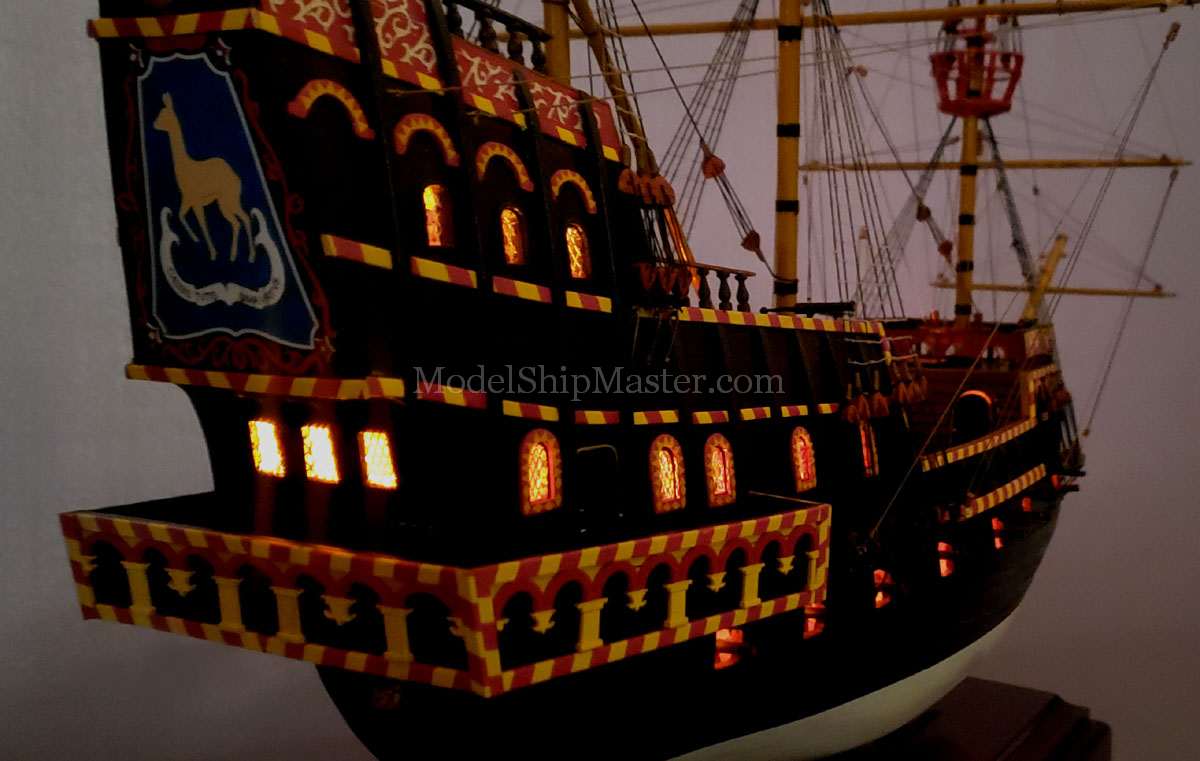
In March 1580 the Golden Hind crossed the Indian Ocean.
In June, Drake rounded the Cape of Good Hope in southern
Africa where rainstorms were gratefully received to
refill the ship’s empty freshwater caskets. Drake sailed
up the Atlantic coast of that continent to reach Sierra
Leone in July. Towards the end of August, the sailors
reached the Canary Islands and then made port at La
Rochelle in western France. Back on the familiar home
stretch, Drake arrived at Plymouth on 26 September 1580.
The voyagers around the world, albeit not in a direct or
even hurried manner, lasted two years and nine and a
half months.
Long given
up for dead, the Plymouth residents were amazed to see
Drake and the small ship return into Plymouth Harbour in
September 1580. Once Drake had been reassured that Queen
Elizabeth I was still alive, he landed the Golden Hind
full of treasure and jewels, and in the process became
one of the most famous men in the world. The journey
remains one of the greatest voyages in history. On a
ship barely 100 feet long, weighing 120 tons, with
rudimentary navigational aids, Drake had sailed right
around the globe and brought back almost unimaginable
treasures.
Much more important at the time than the geographical
achievement was the treasure Drake had been relentlessly
filling his ship with along the way. The estimated value
of the loot was perhaps £600,000 (more than double the
entire annual revenue of England), and the queen
personally received a handsome £160,000. On arrival, the
queen invited Drake to an audience at Richmond Palace
and told him to bring some choice samples of his
fabulous treasure.
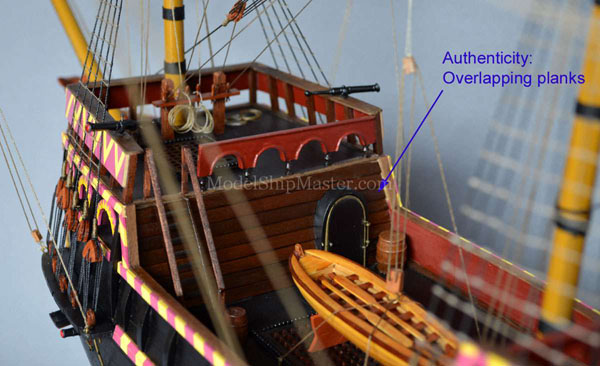 |
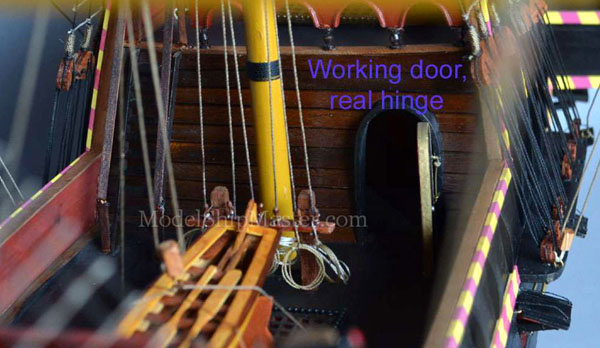 |
On 4 April 1581,
Elizabeth boarded the Golden Hind docked at Deptford
on the Thames and, pleased with the treasures he had
captured and the glory of his navigational
achievements, knighted Drake on its decks. This
outraged the Spanish ambassador who regarded Drake
as nothing more than a pirate. However, if the queen
knighted Drake and took from him a part of his gains
– and queens do not deal in stolen goods – then he
could not have been acting as a pirate but as a
representative of his monarch. The message to Spain
was clear: allow legitimate trade in the New World
or face the privateers.
Drake gave
his queen lavish gifts such as a gold crown embedded
with five huge emeralds and a diamond-studded cross. The
queen gave gifts in return, notably the silver cup in
the form of a globe which encased a coconut Drake had
brought back from his voyage. Another present was the
now-famous Armada Jewel by Nicholas Hilliard in 1588,
a gold and gem-encrusted brooch carrying two portraits
of the queen. Drake, in terms of cash in his pocket, was
probably then the richest man in England and he splashed
out on a portfolio of properties which included Buckland
Abbey. He acquired, too, a coat of arms (a ship atop a
globe with two silver stars intersected by a wavy
horizontal line or fess). His official motto became Sic Parvis Magna or ‘Greatness from Small Beginnings’.
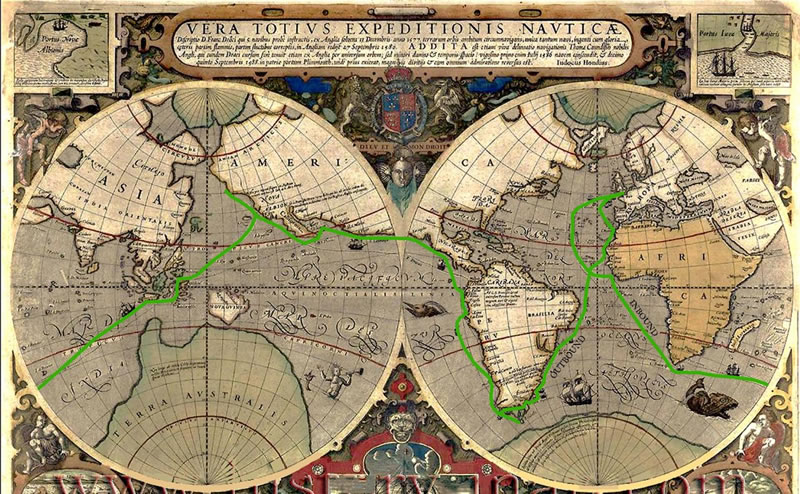 |
After Drake's
circumnavigation, the Golden Hind was maintained for
public exhibition in Deptford. This was the
earliest known example of a ship being maintained
for public display because of its historic
significance. Golden Hind remained there for nearly
100 years before she eventually rotted away and was
finally broken up.
The table in the Middle Temple Hall (in the City of
London) is made from the wood of the Golden
Hind, as is a chair in the Great Hall, Buckland
Abbey, Devon.
Sir Francis Drake's accomplishments were
unparalleled by any of his contemporaries. No
compatriot's, no foreigner's reputation
surpassed his fame. Yet he was very much an
Englishman and a man of his own day and age.
Like his Queen, Drake, however, proved to have a
humanity towards enemies that was far in advance
of his times. |
On 4 April 1581,
Elizabeth boarded the Golden Hind docked at Deptford
on the Thames and, pleased with the treasures he had
captured and the glory of his navigational
achievements, knighted Drake on its decks. This
outraged the Spanish ambassador who regarded Drake
as nothing more than a pirate. However, if the queen
knighted Drake and took from him a part of his gains
– and queens do not deal in stolen goods – then he
could not have been acting as a pirate but as a
representative of his monarch. The message to Spain
was clear: allow legitimate trade in the New World
or face the privateers.
Drake gave
his queen lavish gifts such as a gold crown embedded
with five huge emeralds and a diamond-studded cross. The
queen gave gifts in return, notably the silver cup in
the form of a globe which encased a coconut Drake had
brought back from his voyage. Another present was the
now-famous Armada Jewel by Nicholas Hilliard in 1588 CE,
a gold and gem-encrusted brooch carrying two portraits
of the queen. Drake, in terms of cash in his pocket, was
probably then the richest man in England and he splashed
out on a portfolio of properties which included Buckland
Abbey. He acquired, too, a coat of arms (a ship atop a
globe with two silver stars intersected by a wavy
horizontal line or fess). His official motto became Sic
Parvis Magna or ‘Greatness from Small Beginnings’.
.jpg) |
.jpeg) |
This primarily wood Golden Hind model features:
- Authentic
extensive rigging system comprised of
many different sizes of rope and features numerous
blocks and deadeyes.
-
Blackened metal cannons and wooden carriage. Under the main deck, all guns are "real" guns which
have proper barrels and wooden carriages which sit
on a real deck.
- Scratch-built,
plank-on-frame
construction.
-
Wood figurehead, not resin casting
33" long x 26" tall x 12.5" wide $2,790
 Shipping and insurance in
the
contiguous US included.
Other countries, $400 flat rate.
This model is in stock and can be shipped within 5
business days.
Shipping and insurance in
the
contiguous US included.
Other countries, $400 flat rate.
This model is in stock and can be shipped within 5
business days.
Nobody builds better
tall ships than ModelShipMaster. Click
here
to learn more.
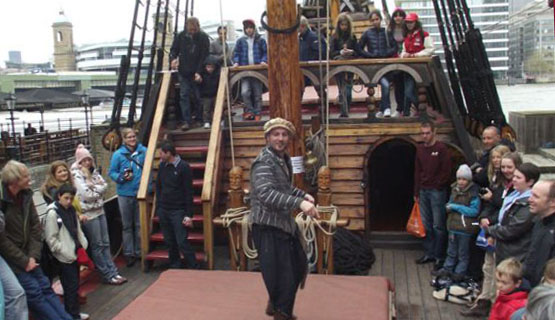
Learn more about the
Golden Hinde here:
https://en.wikipedia.org/wiki/Golden_Hind
https://brewminate.com/francis-drakes-circumnavigation-of-the-globe-1577-1580/
|